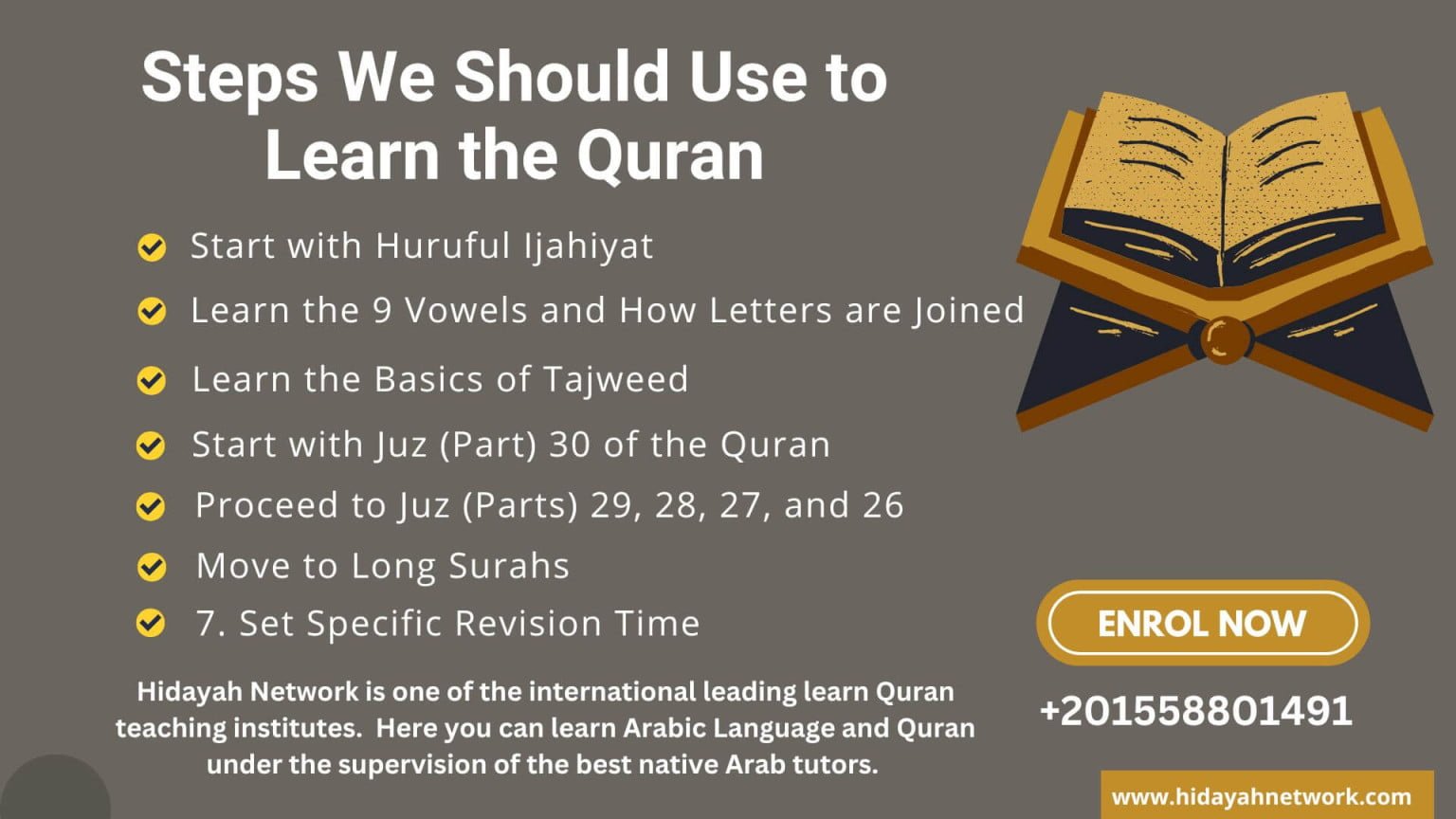What Order We Should Use to Learn the Quran

- Hidayah
- Network
- | Role: Hidayah Network

If you call five people who have learned or memorized the Quran and ask them in what order they learn the Quran, you are likely to get different answers. It means there are many orders in which the Quran can be learned.
If you compare the revelation of Surahs in the Quran and how the Quran was arranged, you will notice many differences, For example, Suratul Alaq was the first Surah revealed to Prophet Muhammad, but Suratul Fatiha is the first in terms of how the Surahs of the Quran were arranged. Although the companions of the Prophet didn’t arrange the Surahs according to their wish, they arranged it according to how the Messenger of Allah (peace and blessings of Allah be upon him) told them to arrange it.
7 Steps We Should Use to Learn the Quran
For us, this is the best order that should be used to learn Quran.
1. Start with Huruful Ijahiyat
Huruful Ijahiya is a compilation of basic Arabic letters. It is the first thing a person that wants to learn the Quran is taught no matter his or her age. Just like the English language, the first thing you will be taught is the alphabet A to Z.
Huruful Ijahiyat consists of Arabic letters that everybody must know because the Quran itself consists of the Huruful Ijahiyat.
Huruful Ijahiyay consists of 28 letters which are Alif, Ba, Ta, Tha, Jim, Ha, Kha, Dal, Zal, Ra, Zain, Sin, Shin, Sad, Dad, Ta, Za, Ain, Ghain, Fa, Qaf, Kaf, Lam, Mim, Nun, Waw, Hau and Yau.
2. Learn the 9 Vowels and How Letters are Joined
After the Huruful Ijahiyat comes the 9 vowels which are Fatha, Kasra, Dumma, Shadda, Sukoon, Mad, Fathataan, Kasrataan, and Dommotan.
These vowels have different sounds they produce when they come in contact with the Arabic letters. All vowels are placed at the top of a letter except for Kasra. Kasra is placed at the bottom of a letter.
It is important to know how each vowel sounds when it is placed at the top or the bottom of a letter.
After learning the vowel sound, the next thing is to learn how two, three, four, or five words are joined together. Once you know how to join together, you are gradually progressing.
Teachers lay a lot of emphasis on how words are joined together because it is one of the most important branches of knowledge needed to recite the Quran beautifully. Without it, it will be difficult or almost impossible to recite the Quran.
Here is an example of how words are joined together.
If the vowel Fatha is placed on Alif, it gives the ‘Ha’ sound. When you add the letter ‘Lam’ to it with a sukoon on the ‘Lam’, it becomes ‘Al’. If the letter ‘Ha’ with Fatha is added to ‘Ha’, it becomes ‘Alha’. When ‘Mim’ with sukoon is added to ‘Alha’, it becomes ‘Alham’. If the letter ‘Dal’ with a Dumma is added to ‘Alham’, it becomes ‘Alhamdu’.
This is a simple explanation of how the letters are joined together to become words. When words are joined together, they become sentences or verses.
Get 40% OFF Now!
3. Learn the Basics of Tajweed
Tajweed is a very wide field. You continue to know more as you continue to progress. But you can start with the basics. One of the basics can be to learn the Quran rules of Noon Al Sakinah and Tanween.
Under these rules, you will learn what is known as Izhar, Idgham, Iqlab, and Ikhfaa. After learning these four rules, you can proceed to Ahkamul Madd and others. With this you can learn the Quran with Tajweed, you will be able to recite a large portion of the Quran correctly.
4. Start with Juz (Part) 30 of the Quran
Ideally, it is better to start from the easiest to the hardest in order not to get overburdened. Part 30 of the Quran is the last chapter. It contains 37 surahs which were mostly revealed to Prophet Muhammad (peace and blessings of Allah be upon him) before he migrated to Medina. One of the attributes of the surahs in this part is that they are short and very easy to understand. Therefore, it is better to start with them before others.
5. Proceed to Juz (Parts) 29, 28, 27, and 26
After mastering part 30, you can proceed in descending order. The reason is that the surahs in parts 29 to 26 are lengthier than part 30 but they are still average compared to the remaining parts. Juz 29 begins at Suratul Mulk and ends at Surat Al Mursalat. Juz 28 begins at Surat Al Mujadala and ends at Surat al-Tahreem. Juz 27 begins at Surah Dhariyat and ends at Sura Al Hadid while Juz 26 begins at Suratu al-Ahqaf and ends at Surah Qaf.
6. Move to Long Surahs
By the time you finish with the five Juz mentioned above, you will have been familiar with the words of the Quran. After that, you can now proceed to long chapters like Suratu Baqara, Surah al-Imran, Surah An-Nisa, Surah al-Araf, Surah an-Anam, Surah Tawba, Surah Hud, Surah Yunus, Suratu Yusuf, Surah ar Ra’d, and Suratu Ibrahim. By the time you finish with all these chapters, your recitation will have been perfected. You will be able to recite the Quran anytime and everywhere.
7. Set Specific Revision Time
When you go through all these processes and you finally achieve your aim, the next and most important task is revision. Without constant revision, you might forget everything you learn.
Pick a specific time of the day for revision and make sure it is constant. Also, observe your five daily prayers as they can serve as an avenue for revision. Furthermore, do not forget to wake up at night for Tahajjud as this is another avenue that can be used to revise. Solatu Duha and Solatul Witr can also serve as good platforms to revise the Quran. May Allah grant us the knowledge and wisdom to learn the Quran. May Allah give us a retentive memory to retain the Quran in our brains after we have learned it.
Conclusion
At the beginning of this article, we made mention of how the Quran can be learned in different orders. In as much as we agree with that, we believe these 7 orders are the best orders to use to learn the Holy Quran.
Frequently Asked Question
Memorize the well-known chapters first before moving to other chapters
The fastest way is to say a single verse at least 4 or 5 times while reading it on the page. Then cover the Mushaf and say it out loud from your memory.
It can be done by setting a specific time for it. You will have it at the back of your mind that once it is time, you won’t do any other thing except Quran memorization.
It says do unto others, as you would have them do unto you.

About Author
